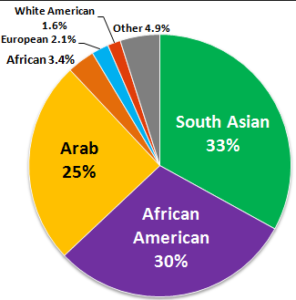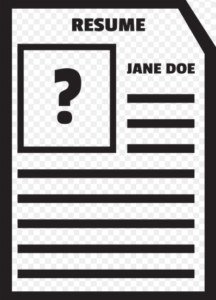The world of recruiting is constantly evolving. We often hear about AI robots in recruitment (like Vera), which aim to shorten the long hiring process and to eliminate bias. Another approach set to change the way we hire is blind recruiting. It may have started back in the 1970s when orchestras used blind auditions to ensure female musicians were given a fair go, but blind recruiting in a more traditional field only really gained momentum a few years ago. The idea is to remove part or all of the personal details from your candidates’ resumes and cover letters. This can include names, age, gender, education, ethnic background and even hobbies. Once you’ve eliminated all that information from the applications, you aren’t left with much, especially for first-time jobseekers. However, before writing it off as another politically correct movement, there are some interesting aspects of blind recruiting to consider.
Before you use blind recruiting
Study your past applicants

Consider your new vacancy
Depending on the position you want to fill, your candidates’ personal details could make a difference to their work and integration within the company. Before opting for blind recruiting, ask yourself the following questions:
Is personality a part of the job requirements? If you are looking to hire a writer or an artist, then you want to have an idea of their creativity and their style of writing. If you are hiring someone for a job where image is important, you want to see your candidates to ensure they reflect the company image.
- Does my future employee need to work in a group? Like it or not, teamwork sometimes requires certain assets that you can’t read off an anonymous CV. An introvert or a domineering personality can be difficult to spot when you don’t know anything about your candidate’s hobbies, their physical appearance or background. This information can even be utilised by candidates to make their application more appealing to recruiters, and outweigh aspects that play against them. See our article on personal information on a CV.
- Will the other employees be open to diversity? Some cultures (in China and India for example) have a strong cast or class system, which can be an issue in the office space. Though your intentions for diversity might be noble, you run the risk of creating animosity among your employees if you are not aware of such issues. To avoid problems later, face them during the hiring process.
How to use job boards for blind recruiting efficiently
Since candidates include personal information when applying to job offers, blind recruiting requires an additional step in the hiring process. An impartial member of staff would need to go over all the applicant CVs and profiles to remove any information that could create a bias. This can be time-consuming and it could also mean removing potentially useful information (since they are not necessarily aware of what the recruiter is actually looking for in order to remain objective). There are companies (like Orange in France) that resort to such measures to avoid any legal problems later, but realistically, not everyone can afford to invest more money into the recruitment process. Luckily, knowing how to use a job board correctly means you won’t need another middleman.
Choosing your job board
In 2018, there are hundreds of job boards to choose from. Each one has different confidentiality clauses, different filters and different account requirements. By choosing a job board which keeps its candidates relatively anonymous, you are less likely to be influenced by their personal information. Furthermore, some websites have even been accused of descrimination, like Facebook, for targetting particular audiences. For more information about which job board to use based on your location and your industry, check out some of our job board profiles, and more specifically, the Jobboard Finder Opinion section (which we are currently developing).
Your choice will also be influence by the information you wish to hide. How blind do you want to go? If you feel you are ignoring certain minorities or if your statistics point to a particular prejudice, it’s a good idea to hide only the information which could be prejudicial. That way, candidates don’t lose their identity completely.
Writing your job offer

This also gives candidates an opportunity to highlight some of their strong points, which they might have neglected to mention (if candidates comes from a very good university for example, they might not feel the need to list their extracurricular activities. If the education is removed, they can replace it with more specific activities).
Designing tests and questions
Lastly, tests and questions in an application form can be used to narrow down the list of candidates. Some job boards encourage companies to include personalized questions (like Indeed), and there are even different online businesses that can help design quizzes that test personality and skills based on the job requirements.
Ultimately, blind recruiting has its limitations, which means it has to be adapted to your situation. At the end of the day, companies hire people at least partially for their personality, and not in spite of it. Blind recruiting does not mean the process has not be completely blind. It can definitely be useful to fight first impressions. Once you have decided to see more of a candidate, work on truly seeing them.
Think bigger, go further

Ultimately, it is more important to focus on changing mindsets inside the office before bringing new employees into a toxic environment. If a woman runs the risk of being undermined or disrespected in a high profile position, the hiring process is just the tip of the iceberg. Avoiding bias during the hiring process thanks to very artificial and unrealistic measures is only temporary if bias exists within the company.
Author: Ali Neill
As the job board tester and blog editor for the Jobboard Finder, Ali works on job boards from all around the world and keeps a close eye on the recruitment trends thanks to a number of sources, including the website’s social media pages.

























« How the Trade Wars Affect Recruiting
How to Recruit in the Philippines »


 Is personality a part of the job requirements? If you are looking to hire a writer or an artist, then you want to have an idea of their creativity and their style of writing. If you are hiring someone for a job where image is important, you want to see your candidates to ensure they reflect the company image.
Is personality a part of the job requirements? If you are looking to hire a writer or an artist, then you want to have an idea of their creativity and their style of writing. If you are hiring someone for a job where image is important, you want to see your candidates to ensure they reflect the company image.